


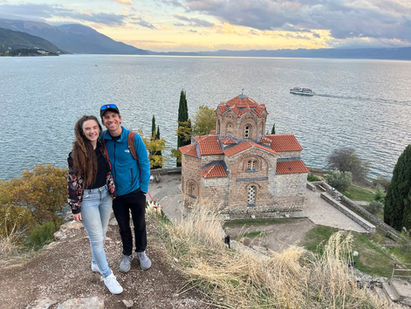
Aug 1512 min read



Krakow was a city that intrigued us, and it came highly recommended. From its storied history and stunning architecture to the lively vibe of its old town, Krakow lived up to its reputation as a must-visit city in Europe. Jelley had recently spent time in Warsaw on a work trip, enjoying her final project in Poland’s capital. Initially we had planned to explore more of Poland together, returning to Warsaw and heading north to Gdansk to see the famous port city on the Baltic coast. However, when the chance to attend the Paralympics came up, we reshuffled our itinerary, choosing Krakow as a more logical starting point for our journey.
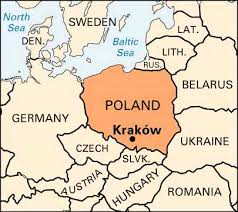



We arrived in Krakow and found ourselves staying conveniently close to the train station, making it easy to get around the city and beyond. Krakow immediately charmed us – its compact old town is perfect for wandering, packed with impressive landmarks, and surrounded by plenty of day trip options.






We love starting our time in any new place with a free walking tour to get a feel for the city, and Krakow was no exception. We joined two tours, soaking in Krakow’s history and hidden gems. Our first tour led us through the picturesque old town and Wawel Castle, where 17 Polish kings were crowned and buried. Our guide, an art enthusiast, also showed us one of Da Vinci’s rare female portraits at the art museum, the Lady with an Ermine, valued at over 1.2 billion zloty (300 million USD).






Krakow felt like stepping back in time, with its remarkably preserved medieval architecture - a rare sight in Europe, as many cities faced severe WWII destruction. While Warsaw was largely flattened after the Warsaw Uprising, Krakow remained mostly intact, claimed by the Nazis as a “forgotten German city” in propaganda and somewhat protected. Despite this misinformation, Krakow’s heart and heritage remain deeply Polish, a testament to their resilience throughout history.






Our second walking tour took us through Krakow’s Jewish Quarter, a neighbourhood steeped in layers of Jewish heritage, resilience, and heartbreaking history. Before World War II, Krakow was home to around 70,000 Jews. Though Jewish communities across Europe were often treated as outsiders, Krakow offered a relatively safe haven for centuries, with Jews making up about 30% of the city’s population at one point. They became merchants, doctors, and scholars, establishing a thriving cultural and economic presence in the city. Jews were not allowed to own land, which led many to excel in business and trade, and by the 1800s, they held significant roles in Krakow’s society, owning half of the city’s businesses and making up 60% of the university students. Walking through the district, we saw the 15th-century synagogues, each a testament to the community’s lasting impact. To afford a private synagogue, one had to be wealthy and connected, able to gather at least ten Jewish men for services. Despite the influence they held, Jewish residents were often marginalized and turned to each other for support, building tight-knit networks that carried them through tough times.






World War II cast a dark shadow over the Jewish Quarter. When Nazi Germany invaded Poland, Krakow was claimed as an “ancient German city” and promoted as such in Nazi propaganda. The Jewish population was forced into a small ghetto, where the number of residents swelled from 3,000 to 17,000, crammed into an area that could barely sustain them. While some Jewish leaders managed the ghetto’s basic needs, the overcrowding and lack of resources created unbearable conditions. Eventually, residents were “relocated” under the guise of work assignments, but many were sent to concentration camps.






Our guide pointed out the haunting memorial in the ghetto’s main square, where 65 empty chairs symbolize the 65,000 Krakow Jews who lost their lives. We learned about a courageous non-Jewish pharmacist who was permitted to stay in the ghetto, providing medicine and support to those trapped there, documenting the horrors she witnessed. Sites like Schindler’s Factory on the outskirts of the ghetto also stand as reminders of both the atrocities and acts of resistance that defined this era. After the war, this area was nearly abandoned, but it was later repurposed to house the poor and homeless under communist rule. In the 1990s, the neighborhood began transforming once more. Artists and entrepreneurs brought a new energy, opening bars, galleries, and cafes. Today, Krakow’s Jewish Quarter is one of the city’s most vibrant areas, where locals and visitors gather around the main square to enjoy zapiekanka, Poland’s beloved open-faced sandwich.
We had intended on visiting the Auschwitz Concentration Camp during our time here, but with our late change in travel plans we were unable to secure tickets, with the only available option a tour in Polish. We've also heard it is a very intense but important experience, and is perhaps somewhere we may return to on a future trip. We instead reflected on our learnings from the Jewish quarter tour, and rewatched Schindler's List that evening, which suddenly felt a lot more real after setting foot in the streets the events took place.
The following day, we visited the Wieliczka Salt Mine near Krakow. It was super cool, albeit somewhat more touristy than our liking. We began by descending 378 wooden steps into the mine, reaching a depth of 64 metres (210 feet), though the deepest point on our tour took us 135 metres (443 feet) underground. The mine itself stretches to a staggering 327 metres (1,073 feet), deep enough to fit the Eiffel Tower with room to spare! Over 700 years old, the mine was discovered in 1280 when locals searching for water instead found salt – a discovery that would transform the region. The entire mine, with its 250 kilometres (155 miles) of corridors and 2,000 chambers, was carved by hand using pickaxes and hammers.






As we explored more of the mine, we marvelled at the incredible craftsmanship of the miners. The walls, floors, and even chandeliers were all made of salt, with some sections resembling marble. Highlights included sculptures and St. Kinga’s Chapel, an active underground church where services and even weddings still take place. We also learned about the practicalities of life underground – from the 100 horses that once lived and worked in the mine to the shifts of 8–10 hours endured by miners. Known as “white gold”, salt was so valuable that a single cylinder weighing 800 kilograms (1,764 pounds) could purchase an entire village. Though mining ceased in 1996, the site now attracts up to 10,000 visitors daily, preserving its legacy as both a historical marvel and a symbol of the region’s wealth and resilience.










After 3 full days in Krakow, we took a bus to Zakopane, the gateway to the Tatra Mountains on the border with Slovakia. While we had heard Zakopane is very touristic, we were excited by the opportunity to hike in the Tatra Mountains, which are part of the Carpathian Mountains, and is the highest range in central / Eastern Europe.


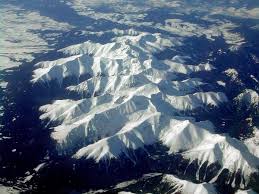

Like many mountain ranges in Europe, it was very difficult to find information online on the Tatra Mountains and how to go about hiking through it. With so many different options of interconnected trails, Luke had spent considerable time in Frankfurt researching both the Polish and Slovakian sides of the mountain range and created a fun hiking itinerary for us. The first refuge booked was at Morskie Oko, described as ‘the Lake Louise of Poland’.
Unfortunately the weather forecast was not good for our time in the Tatras. While in Zakopane, we went to the visitors centre, where we not only got more detail on the weather forecast for the coming days, but we also found out about a critical road/trail closure. We determined this was actually a good thing as the tourists usually travelling on this road by horse-drawn carriage for a day trip to Morskie Oko wouldn’t be there and we might have this piece of paradise nearly to ourselves! With a high wind gust warning in place though, the visitor centre lady advised it would not be safe to proceed with our initial plans. Ah well, that’s the joy of hiking. Flexibility! We know how quickly things can change in alpine environments, so heeded the professional’s advice and extended our stay in Zakopane by another night, which we had named ‘the Queenstown of Poland’.






Our Zakopane accommodation was unexpectedly gorgeous and just 40€ a night, so we were very happy use this extra time to catch up on life admin and start planning for our future travels over the coming months. It was also really nice to have our own kitchen to prepare meals - eating out every single day when travelling definitely loses its novelty.
Instead of the mountain hike to Morskie Oko which we had originally planned, we set out for a shorter day walk in a sheltered neighbouring valley recommended by the ranger. We used the national park shuttle from the main transport hub of Zakopane to reach the trailhead, and we were really impressed with the efficiency of the system with regular departures to trailheads and points of interest throughout the park, reducing the congestion of vehicles on the road and in parking lots. Perhaps this is something other tourism hubs facing similar issues with high visitor numbers could learn from!










We stuck to an accessible, sheltered trail on the valley floor and were thankful to not be amongst the treacherous clouds in the surrounding mountain peaks. There were various side trails heading upwards from the main valley floor, and we we couldn’t resist the temptation of something a little more adventurous. We took a small detour following a sign toward a cave, and felt really lucky as the sign said the trail would be closed during the following 3 days. This was until we translated another sign later saying it was closing to replace the ladders and chains on the trail because they were too dangerous!! Whoops.












It felt great to get the legs moving again, and to be out in nature. We hadn’t realised how much we missed surrounded by the mountains while we were living in Frankfurt until this walk. The trail terminated at a small lake and we arrived at the same time as a group of school kids, which definitely wasn’t the lake we initially planned for, but it was still a cute spot. This was a popular area, especially given the weather conditions, and we came across nearly 100 people (mostly Poles) at the first of our PTTK huts. We didn’t realise that the huts in Europe usually came with full kitchen and bars, we were a little envious of their hot potato pancakes and cold beers as we ate our pre-made cheese & salami sandwiches. The wind and rain picked up through the valley, and although our bodies wanted to keep moving, our minds new it was sensible to return home to our cosy apartment in the hope of a better forecast for the next days. We even spotted a little fox on the walk back. It was the icing on the cake of a great day hike.








The following day, we woke to pouring rain and no visibility in Zakopane, but the forecast showed it would all clear and the conditions would improve significantly from 10am. We decided to brave it and go for ‘take 2’ to reach our goal of Morskie Oko. We sheltered in a cute cafe under the historic train station, then took the bus at 10.30am hoping for the best by the time we reached the trailhead 45 minutes away. It was quite obvious that many others on the bus didn’t know about the main road closure to reach Morskie Oko, as they were more dressed for a horse & carriage ride than a hike! We set off with the knowledge that we always had an option to return back to Zakopane for the night if the conditions were not suitable and/or safe.
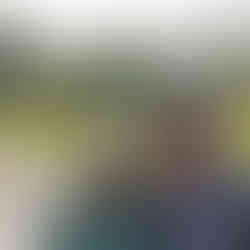





With the road closure (which also doubles as the easy walking track to the refuge), we were taking an alternative hiking route which was not only longer, but also far more challenging. The start of the hike was really nice through the forest, but as we reached the tree line and started ascending, it became clear that the cloud may never lift and our day would be spent with limited visibility and a constant drizzle. Perfect conditions to discover that both Luke’s rain jacket and his pack cover were no longer waterproof!!!






The rocks were rather slippery as we climbed through the fog, and we passed only a handful of other hikers along the way. Towards the top, we saw a sign indicating we were looking right at Poland’s largest waterfall, but would have had no idea otherwise! It was a sad and wet climb up to the top, but we were proud to have persevered.






We were relieved to reach the first mountain refuge, a lively spot buzzing with other soaked hikers. Perched by the picturesque Przedni Staw (or Przedni Lake), this wasn’t our final destination, but the promise of hot tomato soup and homemade apple pie was irresistible for a prolonged lunch stop. For just 8€ (when in Poland!), it felt like the best money we’d spent. It was impressive to find a fully equipped kitchen and bar all the way up here at 1,671 meters (5,482 feet) above sea level, complete with surprisingly stable WiFi. It was super flash compared to the rugged DOC huts of New Zealand’s backcountry - a comforting and much-appreciated upgrade after our damp and chilly trek.
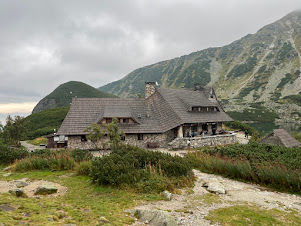




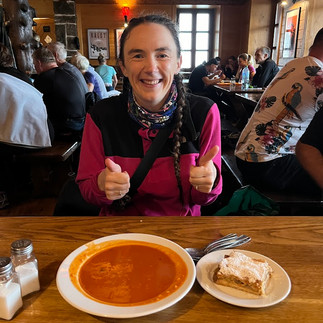
Cold, wet, and with the stubborn clouds refusing to lift, we knew the next leg of our trek to the Morskie Oko hut (where we had booked to stay for the night) would be a daunting challenge. We decided to enquire at the lunchtime refuge about staying the night there instead. To our relief, they had space - not in traditional bedrooms, but on mattresses in the attic, reserved specifically for hikers caught out like us. The attic had a charming, no-frills vibe, reminiscent of a cosy DOC hut setup back in New Zealand. We felt incredibly grateful for this simple yet welcoming option, sparing us from a grueling three-hour trek in less-than-ideal conditions. It was exactly what we needed to recharge and regroup before continuing our adventure.






With near-zero visibility, we had to rely on our imaginations to picture the stunning surroundings we knew were out there. Still, we held onto hope that the forecast would prove accurate and tomorrow would bring clearer skies. As we reviewed the topo maps that evening, we realized we had the flexibility—weather permitting—to take an alternative route out. While this meant skipping our intended destination of Morskie Oko, it seemed far too ambitious to reach it and make it all the way out in a single day. Plus, retracing our steps down the same trail wasn’t an appealing option. Content with our revised plan, we drifted off to sleep dreaming of better weather. Of course, we had that one roommate snoring like a freight train, but all things considered, it wasn’t too bad, and we managed a decent night's rest.






The next morning, we woke to stunning weather as the clouds lifted, revealing the alpine lake and surrounding mountains we hadn’t seen the day before. Over coffee, we decided to explore more of the "5 Polish Lakes," by heading up a nearby ridgeline. The early morning tranquility was magical as we wandered past serene lakes under clear skies. Reaching the ridgeline was a challenge, but the 360-degree views, with Mt. Rysy in the distance, made it worth it. However, the trails beyond the ridge line were steep and much suited more for climbers than hikers, so we decided to turn back and go down the way we came. The descent was much easier, and the quiet trail rewarded us with a close encounter with a Tatra chamois—one of only 900 left of this endangered species.












The sound of a rescue helicopter echoed through the valley, drawing our attention. It wasn’t surprising when we returned to the alpine lakes, when we encountered a massive crowd of people. As we continued toward the turnoff for our descent, the trail became even busier—a stark contrast to the solitude we had experienced the day before. While we had previously walked up a river of water, we were now navigating a river of people! With the Morskie Oko road closed due to the weather, this advanced trail was packed with day-walkers, many ill-equipped in jeans, sneakers, or even sandals. The narrow path left no room for waiting or passing comfortably, creating a chaotic atmosphere.


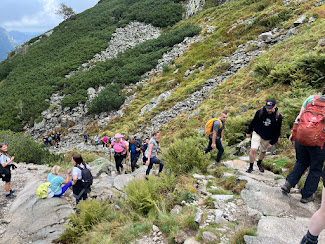



Thankfully, the trail was far less slippery than the day before, though the sheer number of people made it feel dangerous in a different way. In hindsight, the rain had been a blessing in disguise, keeping the trails quieter during our ascent. Despite the crowds, the scenery remained breathtaking. The vibrant green valley stood in sharp contrast to the rugged, exposed rock, and we finally got to see Poland’s largest waterfall up close. Exhausted but relieved, we made it to the car park and eagerly boarded the bus back to Zakopane, reflecting on an incredible and challenging day.
It was a relief to return to a comfortable home with a hot shower and clean clothes. With extra Polish zloty left over - thanks to spending one less night in the mountains and our hut being half the expected cost - we decided to splurge on a nice dinner in town to bid Poland farewell in style and enjoy our final local cuisine.
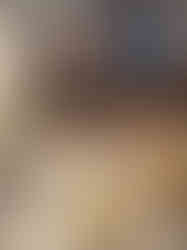



The next morning, we boarded a bus (complete with a fellow passenger’s cat!) to our next destination: the Slovakian side of the Tatra Mountains. Naturally, the weather was perfect for our travelling day but forecasted rain for the next four days of our carefully planned hiking adventure. As they say in events, "The only thing you can’t control is the weather!"

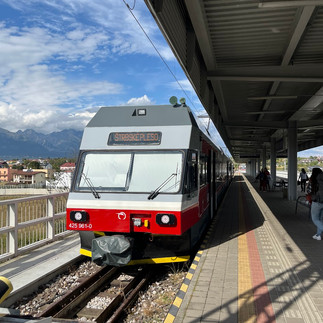




We were curious to compare both sides of the Tatras. Some Poles we had met preferred the quieter Slovakian side over the busier Zakopane area, and now we understood why. Arriving in Poprad, the region’s hub city, we transferred onto an electric tram bound for Nova Lesna, a small rural village. The Slovakian side already felt quieter and more local, with flat farming plains leading dramatically up to the Tatra peaks. The efficient tram system connected towns at the base of the mountains, but with only hourly service, careful timing was needed when leaving the house!
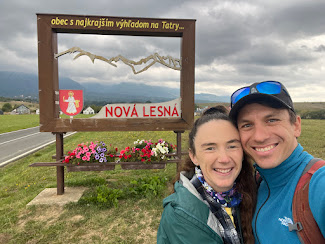





Our guesthouse was an instant hit, thanks to our lively host, Natasa. We quickly discovered the need for planning, as grocery stores in Nova Lesna closed early on Saturdays and stayed shut on Sundays—a throwback to our time in Germany. A few tram stops away was Nový Smokovec, a hub we visited often, serving as the gateway to the national park, trailheads, and tram interchanges. One evening, we ventured to a local spot for dinner—literally in someone’s basement! The food was surprisingly delicious, and at only €1.20 for a glass of wine, we learned Slovakia’s wines are a well-kept secret. Jelley enjoyed the change after Poland’s beer-centric offerings.
The persistent rain forecast forced us to reassess our plans yet again, which had involved 3 nights in different mountain refuges we had pre-booked. We decided to cancel the first night and extend our stay in Nova Lesna, but a visitor center suggestion did inspire an alternative short day walk 'before the rain arrived'. Hopeful for a glimpse of marmots in the meadows, we set out under cloudy skies. The drizzle soon turned into a downpour, and Luke’s new waterproof poncho quickly earned its keep. Fortunately, we found a small shelter, where we were joined by a group of Czech hikers with the same plan. After 30 minutes of relentless rain, we all agreed to turn back. While disheartening, we soon discovered the fact that the rain was actually impacting all of Europe and some nearby countries were grappling with some the worst flooding in decades and we realised we were extremely fortunate to be escaping the worst of it.








Soaked and disappointed , we hurried back to the tram and returned to Nova Lesna. Luke braved the rain to fetch groceries, only to find the store closed. Instead, we stumbled upon a local’s garage-turned-pizzeria, open sporadically when the owner felt like it. The woodfired pizza was surprisingly excellent, accompanied by generous pours of €1 wine. Luke also tried Kofola, Slovakia’s wartime take on Coca-Cola. Less sweet than the original, it wasn’t a favorite but ranked far above Scotland’s infamous Irn-Bru!






The next day, we braved the mountains once again, though the peaks remained hidden in clouds. The forecast promised sunshine, and after a brief spell of rain, we were thrilled to finally walk in dry weather. The trail wound through a lush valley with waterfalls and streams, and before long, we reached the mountain "chata" (or hut) Luke had carefully booked. It was a short walk, but the recently renovated hut was a real treat, offering a hot shower and delicious meal. We even ventured further up the mountainside to catch a viewpoint, savoring the clear weather while it lasted.








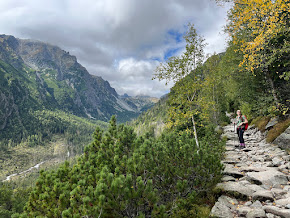



The following morning, rain arrived (again..) just as predicted. We had planned a short walk to the cable car for a ride down to the town, but upon arriving at the station, we were deterred by the €26 fare for such a short trip. Instead, we opted to continue walking instead to Stary Smokovec, which turned out to be a bit of a slog in the rain. But the bright side came in the form of the best pancakes we’ve ever had!! The café’s owner, who had returned from Sydney to renovate his family’s building, shared some fascinating stories, and we were amused by the locals’ surprise at meeting an American - apparently an unusual encounter in this part of Slovakia.






With more rain on the radar, we decided to take a shuttle up to our next hut at 4:30 p.m., saving our energy for the better weather expected tomorrow. We took the electric tram to Strbske Pleso, a scenic 45-minute ride through forests, and even glimpsed blue skies along the way. Onboard, we were delighted to hear a familiar Kiwi voice in the public transport announcements—a neat coincidence, as we had just read about it in an NZ news article.
With some time to spare before our shuttle, we strolled around Strbske Pleso lake in the resort town, a gateway to the neighbouring ski fields and even a ski-jumping complex. The lake sat on a plateau with expansive plains below and offered a beautiful, peaceful view despite the rain easing up. We took a short walk around the lake which was pretty cruisy but was nice to stretch the legs.

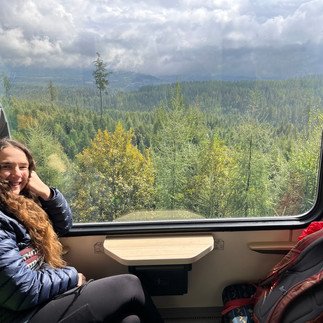




Our next mountain chalet was beautiful, located right on the lakefront, complete with a sauna and wellness centre! Though we didn’t use the facilities, the chalet was lovely and much more affordable than the previous hut, although we did share a bunk room with six others. Many climbers use this as a base for trips up Mt. Rysy (the highest peak in the Tatra Mountains), but we had more modest hiking plans for the morning, hoping the weather would hold.










The next morning started with light drizzle as we set off for our hike to Veľké Hincovo pleso, a scenic alpine lake. The trail was in great condition, despite two hazardous sections: one over a waterfall swollen by recent rains, and another that involved scrambling up rocks. But the clear trail markers made it easier to navigate.








Once we reached the plateu of the summit, the Pleso (or lake) sat neatly nestled in a mountain valley surrounded by mountains. Veľké Hincovo is Slovakia's largest and deepest freshwater spring lake and it was a truly stunning sight.












The hike was everything we hoped for, and we felt incredibly lucky to experience such beauty. Just as we were taking it all in, the wind picked up, signaling time to descend. The perfect hike ended with only a minor setback: Jelley was struck by a falling pinecone on her head, which, while funny in hindsight, was less amusing at the time.
Back at Natasa's guesthouse, we were grateful for clean clothes and a hot shower after a week of mixed weather. Though the elements hadn’t always been on our side, our time in the Tatras had been a wonderful reintroduction to our favorite form of travel - hiking! The Tatras taunted us just as it was time to leave with a beautiful sunrise and perfect blue skies. The 5 hour train journey from Poprad to the capital city of Bratislava, was very scenic and we realised Slovakia had a lot to offer for a small, relatively unknown country!








Arriving in Bratislava felt a little strange after our time in the mountains, but the city’s energy was enjoyable. We stayed in a private room in a hostel in the city center, where Luke couldn’t help but remember that the horror movie The Hostel was based here, adding a slightly eerie vibe to our arrival. Still, we were determined to make the most of our time in the city. To fuel up, we braved the local cuisine at the Slovak Pub, choosing some of the most traditional Slovak dishes we could find. Slovak dishes aren't the healthiest of plates, but we enjoyed experimenting something a bit different. Unfortunately, our menu decisions came back to haunt us in the coming days.. With our bellies full, we embarked on a free walking tour of the city, led by the owner of the Bratislava Free Walking Tours company. The guide was fantastic, and we quickly learned that Slovakia’s capital has much more to offer than meets the eye.










Bratislava is often referred to as the geographic center of Europe, and our guide emphasized that this technically places Slovakia in "Central Europe" rather than "Eastern Europe." This distinction seems to matter deeply to Slovaks, and we had noticed a similar sentiment in Poland. It feels like both countries are eager to distance themselves from the historical and often negative connotations associated with "Eastern Europe," embracing the more favorable and modern designation of "Central Europe" instead.
Bratislava’s history dates back to 1291, but Slovakia as an independent nation is only 31 years old, having emerged from the former Czechoslovakia in 1993. Realising that we’re older than the country itself was a surreal thought! The city has long been a hub of trade, defense, and culture, strategically positioned at the intersection of two major trade routes along the Danube River. Over the centuries, Bratislava has withstood wars, invasions (or "lots of visitors," as our guide humorously put it), and significant transformations, including serving as the capital of the Hungarian Empire for 250 years.







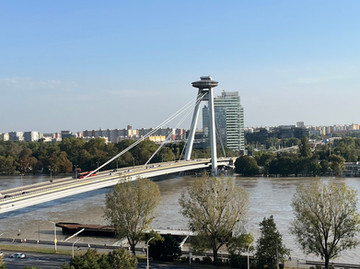


Our guide shared fascinating tidbits, from how the city was shaped by Napoleonic cannonballs to the way Nazi rule, then communism rule, left scars on the landscape. The old town was full of historical sites, such as the remnants of the Jewish district and the imposing Bratislava Castle, which has undergone multiple reconstructions over the centuries. We were also amazed by the fact that Bratislava is a city of wine, not beer, and how Central Europe’s love for pickling and fermenting stemmed from necessity due to the long winters.
After a day of exploring, we were filled with a deeper appreciation for both Bratislava and Slovakia's complex and rich history. It was a fantastic way to wrap up our time in this part of Europe. We were excited to jump off on to our next adventure, somewhere (hopefully!) a bit warmer and less rainy! We were headed back to a country that had left a great impression on us in 2022 and had dreamed of returning to again .. Croatia!
Until then,

- A Kiwi and A Cali











Comments